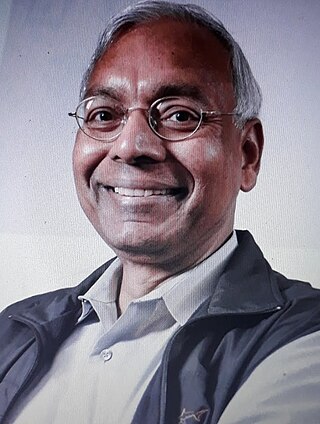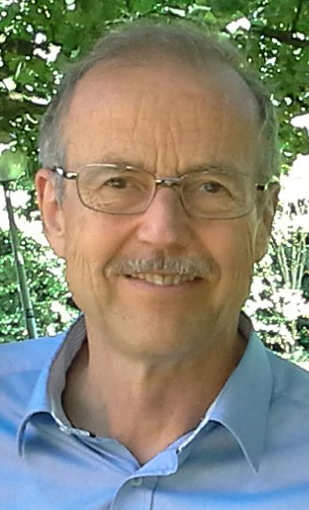Michael Irwin Jordan is an American scientist, professor at the University of California, Berkeley, research scientist at the Inria Paris, and researcher in machine learning, statistics, and artificial intelligence.
Scott J. Shenker is an American computer scientist, and professor of computer science at the University of California, Berkeley. He is also the leader of the Extensible Internet Group at the International Computer Science Institute in Berkeley, California.
Vasant G. Honavar is an Indian-American computer scientist, and artificial intelligence, machine learning, big data, data science, causal inference, knowledge representation, bioinformatics and health informatics researcher and professor.
The random neural network (RNN)is a mathematical representation of an interconnected network of neurons or cells which exchange spiking signals. It was invented by Erol Gelenbe and is linked to the G-network model of queueing networks as well as to Gene Regulatory Network models. Each cell state is represented by an integer whose value rises when the cell receives an excitatory spike and drops when it receives an inhibitory spike. The spikes can originate outside the network itself, or they can come from other cells in the networks. Cells whose internal excitatory state has a positive value are allowed to send out spikes of either kind to other cells in the network according to specific cell-dependent spiking rates. The model has a mathematical solution in steady-state which provides the joint probability distribution of the network in terms of the individual probabilities that each cell is excited and able to send out spikes. Computing this solution is based on solving a set of non-linear algebraic equations whose parameters are related to the spiking rates of individual cells and their connectivity to other cells, as well as the arrival rates of spikes from outside the network. The RNN is a recurrent model, i.e. a neural network that is allowed to have complex feedback loops.
Randy Howard Katz is a distinguished professor emeritus at University of California, Berkeley of the electrical engineering and computer science department.
In queueing theory, a discipline within the mathematical theory of probability, a G-network is an open network of G-queues first introduced by Erol Gelenbe as a model for queueing systems with specific control functions, such as traffic re-routing or traffic destruction, as well as a model for neural networks. A G-queue is a network of queues with several types of novel and useful customers:
In probability theory, a product-form solution is a particularly efficient form of solution for determining some metric of a system with distinct sub-components, where the metric for the collection of components can be written as a product of the metric across the different components. Using capital Pi notation a product-form solution has algebraic form

Yann André LeCun is a Turing Award winning French-American computer scientist working primarily in the fields of machine learning, computer vision, mobile robotics and computational neuroscience. He is the Silver Professor of the Courant Institute of Mathematical Sciences at New York University and Vice-President, Chief AI Scientist at Meta.
Informatics is the study of computational systems. According to the ACM Europe Council and Informatics Europe, informatics is synonymous with computer science and computing as a profession, in which the central notion is transformation of information. In some cases, the term "informatics" may also be used with different meanings, e.g. in the context of social computing, or in context of library science.

Anna R. Karlin is an American computer scientist, the Microsoft Professor of Computer Science & Engineering at the University of Washington.
Albrecht Schmidt is a computer scientist best known for his work in ubiquitous computing, pervasive computing, and the tangible user interface. He is a professor at Ludwig Maximilian University of Munich where he joined the faculty in 2017.
Margaret Martonosi is an American computer scientist who is currently the Hugh Trumbull Adams '35 Professor of Computer Science at Princeton University. Martonosi is noted for her research in computer architecture and mobile computing with a particular focus on power-efficiency.

Anil Kumar Jain is an Indian-American computer scientist and University Distinguished Professor in the Department of Computer Science & Engineering at Michigan State University, known for his contributions in the fields of pattern recognition, computer vision and biometric recognition. He is among the top few most highly cited researchers in computer science and has received various high honors and recognitions from institutions such as ACM, IEEE, AAAS, IAPR, SPIE, the U.S. National Academy of Engineering, the Indian National Academy of Engineering and the Chinese Academy of Sciences.
François Louis Baccelli is senior researcher at INRIA Paris, in charge of the ERC project NEMO on network mathematics.

Shojiro Nishio is a Japanese information scientist and technology scholar and the 18th president of Osaka University. Having co-authored or co-edited more than 55 books and more than 650 refereed journal or conference papers as well as serving on editorial boards of major information sciences journals, Nishio is considered one of the most prominent and influential researchers on database systems and networks.

Brigitte Plateau is a French computer scientist. A former student of the École Normale Supérieure at Fontenay-aux-Roses majoring in Mathematics, she is a Doctor of Information Studies. A University Professor at Grenoble Institute of Technology since 1988, since February 2012 she has been the General Administrator of the Grenoble INP cluster.

Gregor von Bochmann is a German-Canadian computer scientist and emeritus professor of the Université de Montréal and the University of Ottawa. He is known for his work in the area of protocol engineering and distributed applications.

Eugene Wong is a Chinese-American computer scientist and mathematician. Wong's career has spanned academia, university administration, government and the private sector. Together with Michael Stonebraker and a group of scientists at IBM, Wong is credited with pioneering database research in the 1970s from which software developed by IBM, Microsoft, and Oracle descends. Wong retired in 1994, since then holding the title of Professor Emeritus of Electrical Engineering and Computer Sciences at University of California, Berkeley.

Gabriele Kotsis is an Austrian computer scientist. She is full professor in computer science at Johannes Kepler University (JKU), Linz, Austria, while leading the Department of Telecommunication and the division of Cooperative Information Systems. She was vice-rector for Research and the Advancement of Women, and longstanding chairwoman of Universities Austria's Policy Committee on Research. She is a distinguished member and elected president of the Association for Computing Machinery (ACM).

Matthias Grossglauser is a Swiss communication engineer. He is a professor of computer science at EPFL and co-director of the Information and Network Dynamics Laboratory (INDY) at EPFL's School of Computer and Communication Sciences School of Basic Sciences.









